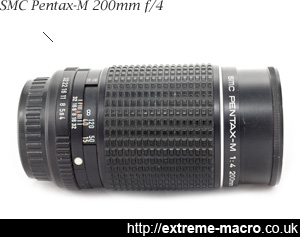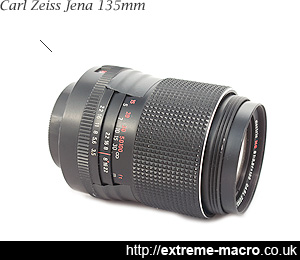Extreme Macro Tube Lenses
by Johan J Ingles-Le Nobel
Last updated November 03, 2021
Tube lenses, also known as relay lenses, are a necessary component of an extreme macro setup using infinite objectives: they take a parallel optical beam coming down from an infinite objective and converge this into the sensor (or film).
That parallelism makes it possible to stick additional components such as filters and beam splitters into the light path, without degrading the image by adding aberrations.
Huh?!!
To explain, there are 2 types of microscope lenses we use for extreme macro, infinite and finite (more details here). You can mount a finite microscope objective directly on your bellows with adaptors and start shooting away, but infinite microscope objectives (like this excellent Nikon 10x here) require another lens between the objective and the camera, which is known as a 'tube lens'. Tube lenses are specialty items that can be purchased, but it is also possible to use your prime telephoto lens as a tube lens, even Raynox adapters.
Tube Lens or Telephoto Lens?
SMC Pentax-M 200mm f/4, which gives me 10:1 as a tube lens using a Nikon CFI BE 10X NA 0.25 infinite objective.
In fact, images from all tube lenses are actually all remarkably similar, both from dedicated microscopy 'tube' lenses and from consumer telephoto lenses.
This is because at their rated magnifications, infinity objectives already stop down the optical system to an effective f stop around 18-20 (depending on objective), and at such a small aperture, most aberrations except for chromatic aberration have been cut down. In other words, the objectives do the heavy lifting and the tube is somewhat secondary.
Extreme macro photographers have obtained excellent results from lenses around the 200mm focal length, either fixed primes, or the long end of a zoom. However, if using a zoom lens beware, as a zoom at less than full focal length will usually (but not always) vignette.
Focal Length & Magnification
200mm or not?
Nikon, Mitutoyo, and Leica infinity objectives were all specifically designed for use with a 200mm tube lens. Zeiss is 164.5mm Olympus is 180mm. Motic is 180mm. Leica and Zeiss do some chromatic correction in the tube lens, the others do not. (Older Olympus infinity used corrective eyepieces). Nikon and Mitutoyo choose to do all of their corrections only in the objective, which makes those objectives play nicely with ordinary camera lenses because no extra correction is looked for.Nikon, Mitutuyo and Leica Infinite objectives achieve their rated magnification on a 200mm tube lens. However, on an APSC sensor, The Nikon and Mitutuyo objectives both have more than enough covering power to work with shorter tube lenses, down to about 100mm, in which case they will deliver a sharper image over a wider field.
On 100mm, the 10x delivers 5:1 magnification; on 200mm it is 10:1 and on 300mm 15:1. But, if using a full frame sensor, the corners will lose quality if you are much below 200mm.
Carl Zeiss Jena 135mm f/3.5. As I only ever use this as a tube lens I taped over the focus mechanism so it would always sit at infinity.
An issue to consider with increasing the magnification by using an even longer tube lens such as a 300mm is empty magnification - whilst an image may become bigger, it does not actually become sharper.
A 10X NA 0.25 objective running at rated magnification is already stopped down to f/20 effective, and as a result of diffraction, there will be only a slight improvement in quality by going from 10X f/20 and cropping, to 15X f/30 and using the whole sensor.
Going the other direction, aberration may become an issue. At some point the corners and then the edges will start to deteriorate because the objective does not cover a wide enough field with high quality image.
Distance Between Objective and Tube
for me, better results are obtained by having the tube and objective close togetherI personally find that for me, better results are obtained by having the tube and objective close together than by having significant distance between them. This is counter to the recommendations of the manufacturers, which encourage distance between tube and objective for optimum results.
They also write that tube lengths between 200 and 250mm are considered optimal, because longer focal lengths will produce a smaller off-axis angle for diagonal light rays, reducing system artifacts.
Do beware though, in some cases mounting very close may give a little loss of contrast due to reflections between the objective and the front element of the tube lens. This can be minimized by flocking or masking all parts of the objective except the actual glass.
Tube Focus
magnification is the ratio of the focal lengthsWhen the tube is focused at infinity, the magnification is the ratio of the focal lengths. However, when the rear lens is not focused at infinity, the magnification will change - it increases marginally because it is focusing on a smaller proportion of the whole. However, there may also be a decrease in optical quality. Generally, the perceived wisdom is that the rear (tube) lens should be focused at infinity to enable the front (reverse) lens to work at its sweet spot. This is my experience as well. For further experimentation regarding this, adding a waterhouse stop between the two has also been known to increase the quality.
Contrast
On tube lenses in which contrast is on the low side, painting accessible surfaces inside of the connection with black matte nail polish may decrease unwanted reflections and therefore increase the contrast. Also, be sure to flock or mask any shiny areas around the back of the objective to avoid any flare from reflections between the objective/adapter and the tube lens.
Raynox as a Tube
A Raynox DCR-250 is a +8 diopter so the focal length is 1000/8 = 125mm. That gives an infinity focused 125mm tube lens. Although a Raynox image has low contrast, Good results have been reported by reverse-mounting a Raynox DCR-250 directly behind the objective it is chromatically very clean and together with the objective and with 10 cm or so of separation between the two lenses the resulting image is very good. The raynox DCR-150 is very close in focal and luminosity at original Nikon tube lens and maybe the best clone of that lens. Good results have been reported by using a Raynox DCR-250, and opinion is divided whether it is better reverse mounted or not.
What makes A Good Tube Lens?
Beyond the obvious parameters of reasonable optical quality, there isn't that much known about what makes for a good tube lens. Many different optics have been tried and tested including even 80mm enlarger lens, but one thought is that the elements of the tube lens need to be close together. The closer they are together the better it will work.
Fullframe: Do Your Homework
The lenses that I've tested are all tests with APSC cameras. That means that there maybe vignetting with fullframe cameras if you use these lenses with those. Bottom line, there's no reliable formula that can give you a reliable or even semi-reliable guide to whether or not a lens works well as a tube lens. If you have a fullframe camera and are looking for a tube lens to use, I'd strongly recommend you have a look at photomacrography.net.
Related Articles







